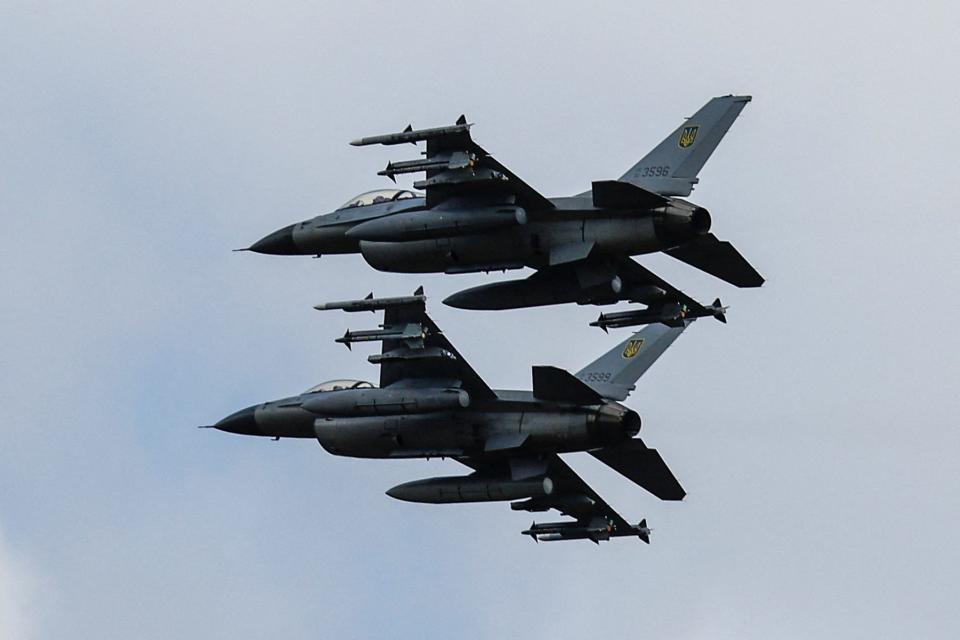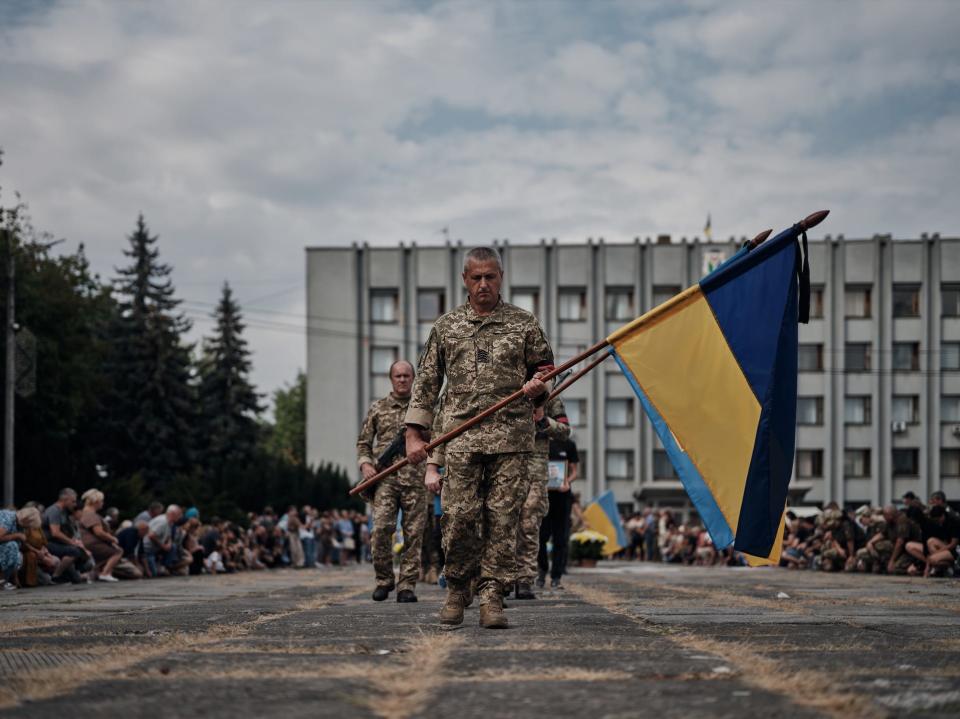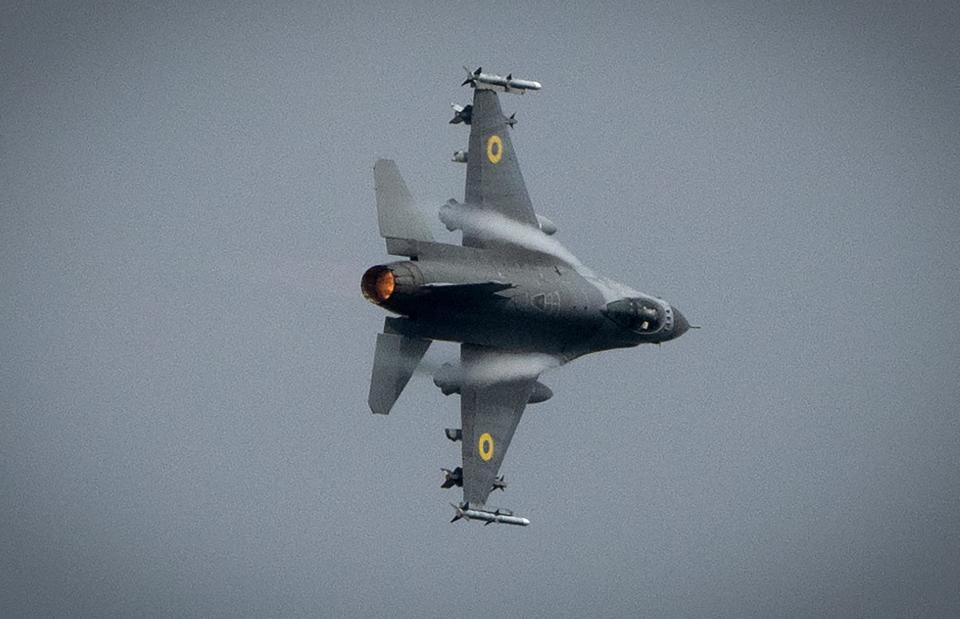-
Ukraine lost one of its few F-16s last week while it was defending against Russian missiles and drones.
-
It was initially thought that Kyiv would use its F-16s for air defense, given the heightened risk of other missions.
-
But the big Russian attack and the jet loss last week show even defensive missions are still dangerous.
Before Ukraine received its first batch of F-16s a few weeks ago, one of the big questions surrounding the transfer was how Kyiv would make use of its small inventory of NATO-provided fighter jets.
When the jets arrived in Ukraine, initial imagery of the F-16s and their missile loadouts suggested Kyiv would use the fighter aircraft in an air-to-air role as opposed to offensive missions where they’d be more vulnerable.
Last week Ukraine’s F-16s flew in combat, defending against a massive Russian aerial attack. But one of them crashed and killed its pilot, underscoring how even the missions initially thought to be of relatively lower risk are still dangerous.
“Flying fighters is a dangerous pursuit even in any situation,” Vincent Aiello, a former US naval aviator who, in addition to flying F/A-18s, also flew the F-16 during his military career, told Business Insider.
Ukraine debut its F-16s to the world in early August after a yearslong wait for the combat-proven jets. The first official imagery of the fighter jets showed them armed with US-made air-to-air missiles, and experts and analysts pointed out that Kyiv would likely use the aircraft in a defensive role.


Alternative missions for Ukraine’s F-16s would be close-air support (CAS) or suppression and destruction of enemy air defenses (SEAD/DEAD) missions.
But Ukraine’s Commander-in-Chief Oleksandr Syrskyi previously said that he wouldn’t want the F-16s flying too close to the front lines, where they might become victims of Russia’s surface-to-air missile systems. He said that, instead, they would strengthen Kyiv’s air defenses.
That’s exactly what the fighter jets did on August 26, providing an extra defensive boost for Ukraine as Russia attacked the country with hundreds of missiles and drones in what was said to be the largest aerial bombardment of the war.
Days later, Ukraine acknowledged one of its F-16s crashed, killing its pilot, while battling Russian missiles during the attack. It’s unclear what caused the fatal incident — whether it was friendly fire, a pilot error, aircraft malfunction, or an enemy munition — but Kyiv said an investigation is underway.
Regardless of what caused the crash, though, the operating environment is undoubtedly challenging during such a massive attack, which involved a mixed Russian strike package.


The Russian bombardment last week included a mixture of one-way attack drones, cruise missiles, and ballistic missiles. Some of the weapons employed were launched from Tu-95 strategic bombers, Su-34 fighter-bombers, and Su-57 fifth-generation aircraft.
On the Ukrainian side, a variety of air defenses came into play to help intercept as many of these threats as possible. These include both Western and Soviet-era ground-based air-defense systems and fighter aircraft like the F-16.
Mike Torrealday, a retired US Air Force colonel who flew combat operations in the Middle East with the F-16, said air defense is a “very delicate dance to execute.”
Attempting to intercept incoming missiles and drones means that the pilots have to shoot at the threats, carefully maneuver the aircraft, and ensure that they’re not crossing into areas where they could be at risk of friendly fire. Furthermore, the risk of spatial disorientation goes up exponentially when doing all of this at night, making it even more dangerous.
“There’s just stuff flying all over the place,” Torrealday said, and being in the wrong place at the wrong time could be very deadly.”


Air defense might be safer than supporting ground forces, knocking out air defenses, or bombing heavily defended enemy positions, but “it’s not a walk in the park by any means,” he added.
Beyond the challenging operating environment, another potential complication for Ukrainian pilots is that the F-16 is still a brand-new capability for Ukraine, and last week marked its first combat endeavor.
Despite the many months of training the pilots received, it’s still an unfamiliar aircraft that is very different from the Soviet-era fighters they’re used to flying.
“I would think that would be a very chaotic environment anyway, exacerbated by the fact that you have a new aircraft and its first week of operation in that conflict,” Aiello said, adding that it’s inherently risky to fly fighter jets and also to operate them in combat.
“You’ve got an increasing level of risk when you’re doing both,” he said.
Read the original article on Business Insider







